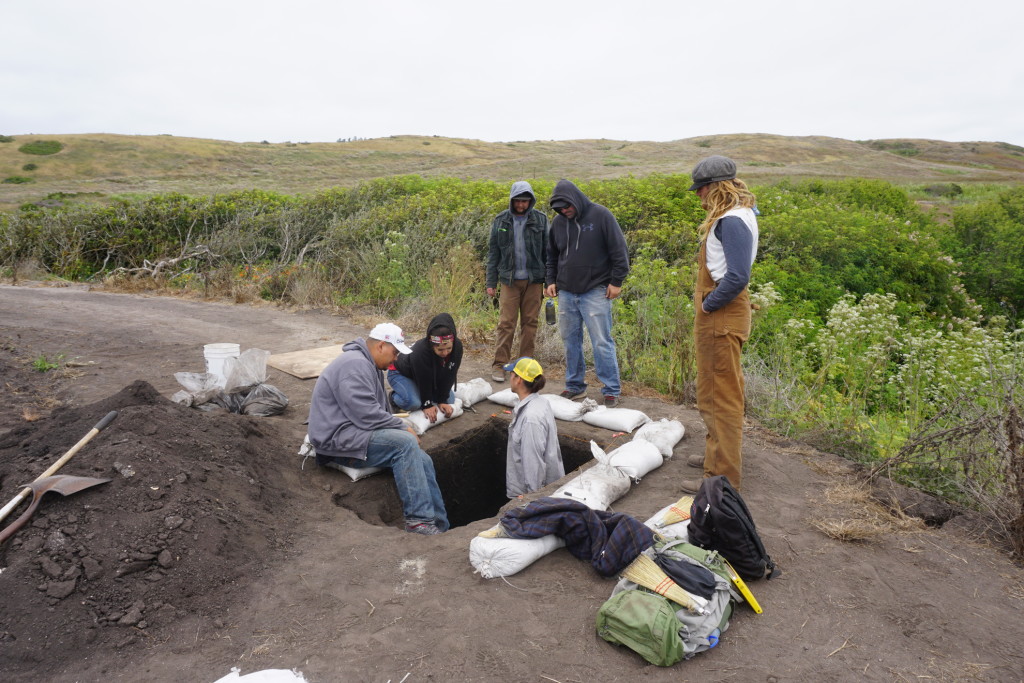ARCHAEOLOGICAL RESEARCH ON THE COAST OF SANTA CRUZ COUNTY
Text by Rob Cuthrell, AMLT Research Associate
Photos by Kent Lightfoot, AMLT Board Member and UC Berkeley Professor of Anthropology

Native Stewards Nathan Vasquez, Vanessa Sanchez, and Josh Higuera-Hood (left to right) work
together with Camp Manager Lupe Delgado (second from right) and UCB graduate students
Gabriel Sanchez (below) and Michael Grone (far right) to excavate a 2000-4000 year old
archaeological site in an agricultural field near Highway 1.
In 2016, Amah Mutsun Land Trust partnered with California State Parks and researchers at UC Berkeley to begin a two-year research project to explore how Native groups lived on the coast of northern Santa Cruz County. The study includes excavations and analysis of materials from five archaeological sites that range in age from less than 200 years old up to nearly 7000 years old. The ultimate goal is to understand how Native people used natural resources in the landscapes around them, and whether these resources and landscapes may have been stewarded to enhance their productivity and sustain their use.
As a collaborative research project, AMLT’s Native Stewards worked together with professors, graduate students, and undergraduates from UC Berkeley to carry out archaeological fieldwork. This summer, eight Native Stewards, led by Tribal Elder Eleanor Castro, participated in the project for three weeks from late May to early June. During the fieldwork, all the participants camped out together in a scenic streamside field at Wilder Ranch State Park, just north of Santa Cruz.

Native Stewards Natalie Garcia, Nathan Verdugo, Gabriel Pineida, and UCB undergraduate Rosario Torres (left to right) screen archaeological materials from surface survey at a site near Laguna Creek.
There were several notable discoveries during our fieldwork this summer. In 2016, we collected archaeological samples from several buried cultural layers in an ancient sand dune on the edge of the coastal bluffs. These cultural layers dated between about 3000 and 7000 years in age, making this site one of the oldest coastal sites in the region. This summer, we explored whether there were buried cultural deposits in the fallow agricultural field system surrounding the sand dune. Using ground-penetrating radar and augering, we found a shell-rich cultural layer beneath the agricultural fields, suggesting people were not living exclusively in the dunes.

UCB undergraduate Miriam Lagunas (left) and Native Stewards Ian Girouard (middle) and Paul Lopez (right) count and weigh archaeological materials recovered through surface survey at an archaeological site near Laguna Creek.
We also investigated an archaeological site of unknown age that had never been studied before. This site, located on a small flat area along a steeply sloping hillside above Laguna Creek, has been relatively undisturbed since the time it was inhabited by Native people. At many archaeological sites, cultural materials have been mixed and destroyed by historical practices such as tilling or earth-moving. But at this site, we discovered intact cultural features buried less than eight inches below the soil surface. One of these features was a cobblestone pile made of rocks that had been brought up from the creek below. It was clear from the coloration and signs of cracking that many of the stones had been heated to high temperatures. These may have been cooking stones used for earth ovens, or they may have been used in a sweat lodge.

Camp Assistant Lupe Delgado (left) and Camp Director and Amah Mutsun Tribal Elder Eleanor Castro (right) prepare a delicious meal for hungry Native Stewards and students at Wilder Ranch State Park.
Analysis of biological materials from the sites–such as animal bones and plant remains–is ongoing, and we should be able to make interpretations about those materials next year. Already it is clear that different types of resources were used at the sites based on their location and the time period. For example, the ancient site in the sand dune system overwhelmingly contains animals that live in or near the ocean, with few plant foods. However the later inland sites contain a mix of coastal resources along with land animals and plant foods. When this project is completed, we will have a better understanding of how Native systems of natural resource use developed and changed through time in this region.






